ISSN ONLINE(2319-8753)PRINT(2347-6710)
ISSN ONLINE(2319-8753)PRINT(2347-6710)
Nazni. P1, Gracia.J2
|
| Related article at Pubmed, Scholar Google |
Visit for more related articles at International Journal of Innovative Research in Science, Engineering and Technology
The barnyard millet is the fastest growing of all millet produces a crop in six weeks. The bran also known as miller’s bran is the hard outer layer of cereal grain. Bread is an important staple food in both developed and developing countries. Response Surface Methodology (RSM) was used to investigate the effects of Refined Wheat Flour (RWF) and Barnyard Millet Bran (BMB) on the bread. In this study, RSM was employed to optimize the ingredient formulation and processing parameters of BMB incorporated bread such as nutrient and sensory score responses. A rotatable central-composite design consisting of RWF and BMB, with 13 formulations for the nutrient and sensory score of the BMB incorporated bread. The result of the optimized acceptability of the BMB incorporated bread containing RWF 87.95g, BMB 7.06g, carbohydrate 93.36g, protein 9.75g, fat 7g, fiber 2.25 and overall acceptability of 6. Hence it is concluded that RSM was used successfully to optimize the level of RWF and BMB for the development of bread.
Keywords |
| barnyard, optimize, response, nutrient, sensory. |
INTRODUCTION |
| Millets are small seeded annual coarse cereals grown around the world [1, 2]. Millets have been food commodities since ancient times due to the important nutritional quality; there is a need to revive their usage in daily diet. Millets can substitute as a major cereal for better health benefits [3]. Millets and legumes form staple food for the population of low income groups in the worldwide [4, 5]. Barnyard is the fastest growing millet grown in India, Japan and China when the paddy fails and used as a substitute for rice. The length of the grain is 2-3 mm and 1-2 mm wide [6]. It is also called as Japanese barnyard millet [7]. In developing countries, millets are consumed by people from the low economic status [8]. The barnyard millet average yield is around 18-20 q/ha [9]. The barnyard millet is a nature’s gift for the modern mankind who is engaged in sedentary activities [10]. Millet bran is a byproduct of millet based food manufacturing [11]. |
| Bread is an important staple food for several countries. Wheat flour is one of the most popular than other cereal grains for bread making [12]. The bread is a fast and convenient food based on wheat products of baked foods and is consumed worldwide [13]. The bread is an ideal product that can serve as a functional food daily used by a large population throughout the world [14]. Bread products are worldwide accepted because of the low cost, easily prepared, versatility, sensory attributes and nutritional properties [15]. RSM is a statistical technique that has been successfully used in the development and optimization of cereal products [16]. RSM consists of a group of mathematical and statistical procedures that can be used to study the relationships between one or more dependent variables and independent variables [17]. The relative contribution of predictor variables to product characteristics is evaluated and allows the optimum ingredient levels [18]. A Rotational Central Composite Design (RCCD) can be used when a comparatively accurate prediction of all response variable averages related to quantities measured during experimentation. Using Design Expert software RSM can be performed for the optimization. Along with optimization RSM was also used to find the effect of correlation between the inputs on the response. Here more than one response can be studied [19]. Gan et al., [20] believe that in order to achieve |
| optimization, RSM will reduce the number of trials and provide multiple regression approach. The optimized ingredients level achieved after the numerical and Graphical optimization for maximum colour, flavor and taste score [21]. The objective of the study is to develop an optimized formulation of the bread containing RWF and BMB using RSM and to determine optimal levels for the responses of BMB incorporated bread. |
MATERIALS AND METHODS |
| The refined wheat flour, sugar, salt, yeast, butter and barnyard millet were purchased from the local market in Salem, Tamil Nadu, India. The barnyard millet was cleaned and the foreign particles were removed, shade dried and grinded manually, sieved and collected the bran. Then the Barnyard Millet Bran (BMB) was uniformly mixed and treated with 20% (w/w) solution of 1% calcium hydroxide and stored in sealed containers. |
| Preparation of bread |
| The ingredients such as RWF, BMB, sugar and salt were mixed for 1-2min. Then, yeast dissolved in 30ºC water, which is the optimum temperature for the yeast cells to be activated, and melted margarine was added to the dry ingredients. All the ingredients were again mixed for 2min and during mixing, water was added to the mixture. After mixing, the dough was kept for fermentation. After that, the dough was divided into 250 g pieces, placed in aluminium baking pan for proofed at an incubation chamber at 35âÃâæC and 80% relative humidity for 30 min in order to maintain the proofing step, which is defined as the last fermentation. Then, the samples were ready for baking. Baking for each sample was conducted in a laboratory oven with air circulation at 210âÃâæC for 40 min. The loaves were removed from the pans and cooled at room temperature |
| Nutritional analysis of bread |
| The samples were also evaluated for proximate compositions by using standard methods of analyses according to AOAC in terms of carbohydrate, protein, fat and fiber. All the measurements were carried out in triplicates and mean values were calculated [22, 23]. |
| Quantitative descriptive analysis of bread |
| Sensory evaluation refers to the evaluation of recipes by sense organs. All the sense organs are used in the appraisal of food [24]. Organoleptic evaluation is generally the final guide to the quality of a food product from the consumer’s point of view [25]. Sensory evaluation on the produced bread was conducted among 10-trained panellists in the Department of Food Science, Periyar University, Salem, Tamilnadu. The trained panellists evaluated all samples and also served with a glass of water to neutralize the taste before analyzing the next sample. The bread were evaluated using 9-point hedonic scale (1= dislike extremely; 9= like extremely) for various characteristics such as appearance, colour, flavour, taste, texture and overall acceptability [26, 27, 28]. |
| Experimental design and statistical analysis |
| Response surface methodology (RSM) was used to study the simultaneous effects of RWF and BMB addition on bread. In designing this experiment by response surface methodology (RSM), a central composite design was employed. Central composite design (CCD) was used to study the interaction of process variables by applying RSM [29]. The design matrix of CCD and also experimental results for the responses such as nutrient and sensory parameters of bread are shown in Table 1. |
 |
| After preliminary baking tests, the upper and lower limits for these variables were established [30]. Two quantitative controllable factors (independent variables) were level of RWF (X1) and level of BMB (X2). The dependent variables were selected as responses for representing the main parameters of bread quality: carbohydrate (Y1), protein (Y2), fat (Y3), fiber (Y4), appearance (Y5), colour (Y6), flavour (Y7), taste (Y8), texture (Y9) and overall acceptability (Y10). After preliminary experiment, the upper and lower limits for the independent variables were established. RWF levels were from 70-100g and BMB level from 5-30g. The experimental data for each response variable were fitted to the quadratic model. |
| where, Y=responses; β=constant; X1, X2=linear regression; X1 2, X2 2=quadratic regression X1X2=interaction regression; X1, X2 = independent variables. The adequacy of the model was evaluated by coefficient of determination, R2, F-value and model p-value at the 0.1 significance. The statistical analysis RSM for bread was performed by using Design Expert with (2000, V 6.0.8; Stat- Ease Inc., Minneapolis, MN, USA) software. Both the manipulated variables and responses were fitted to the quadratic model by performing the analysis of variance (ANOVA). The experimental results were analyzed to determine the lack of fit and the significance of the quadratic model and the effect of interaction between the manipulated variables and responses. |
RESULTS AND DISCUSSION |
| Experimental design results and response surface analysis |
| Results of the experimental design to carbohydrate, protein, fat, fiber, appearance, colour, flavour, taste, texture and overall acceptability of the bread with different concentration RWF and BMB are shown in Table 2. |
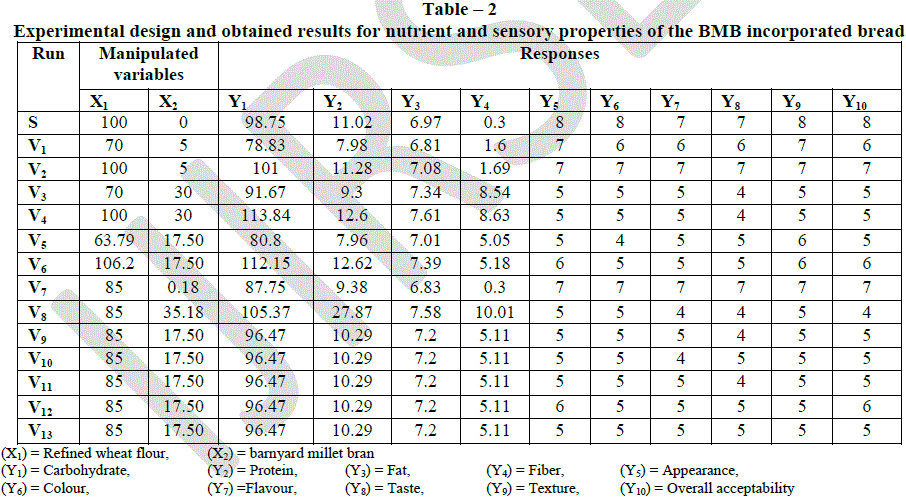 |
| These responses ranged from 78.83 to 113.84g carbohydrate, 7.96 to 27.87g protein, 6.81g to 7.61 fat, 0.3 to 10.01gm fiber, 5 to 8 appearance, 4 to 8 colour, 4 to 7 flavour, 4 to 7 taste, 5 to 8 texture and 4 to 8 overall acceptability. |
| Regression coefficients for independent variables of the BMB incorporated bread |
| Table 3 shows the regression coefficients for the independent variables (RWF and BMB), interactions upon response variables. |
 |
| Vatsala et al., [31] suggested that appearance, colour, flavour, taste, texture and overall acceptability are the main criteria to assess product quality. The nutrient and sensory analysis helps defining the product characteristics which are important with respect to acceptability. |
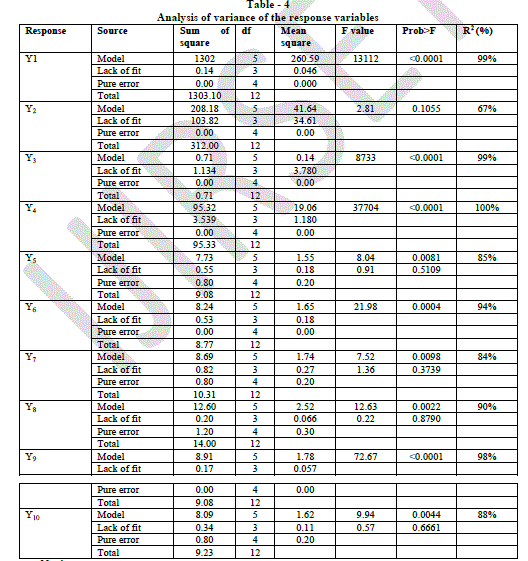 |
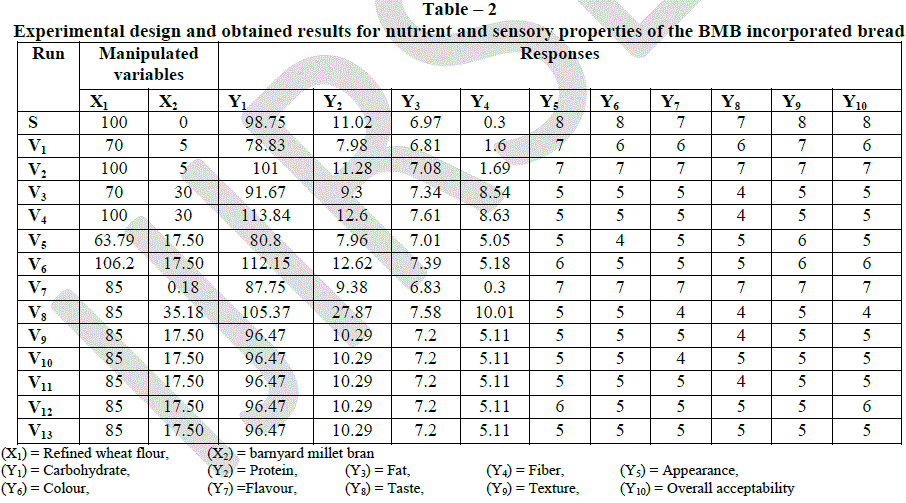 |
| All the independent variables have positive effect of RWF whereas the BMB shows positive effect for nutrient content and negative effect in the sensory properties. The quadratic terms of RWF in carbohydrate, protein, fiber, colour and BMB in carbohydrate shows negative effect on the responses. The interactive terms of colour, flavour, taste and overall acceptability shows negative effect in RWF and BMB respectively. The sensory parameters such as appearance, flavour, taste and overall acceptability shows that the lack of fit is not significant. |
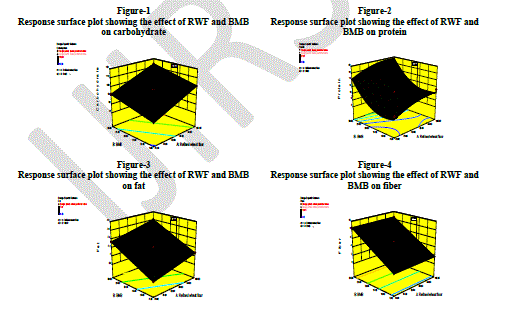 |
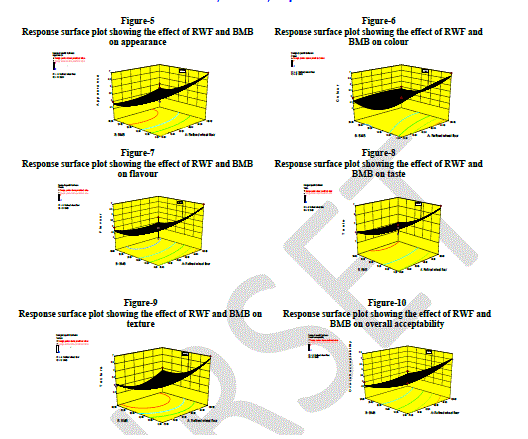 |
| Process optimization through the desirability function |
| In Table 5, conditions of the optimization process to minimum carbohydrate, fat, maximize protein, fiber, appearance, colour, flavour, taste, texture and overall acceptability in the bread are displayed. The selection of bread quality attributes (responses) in the optimization process and their relative importance was based on the literature data and consumer preference [32]. |
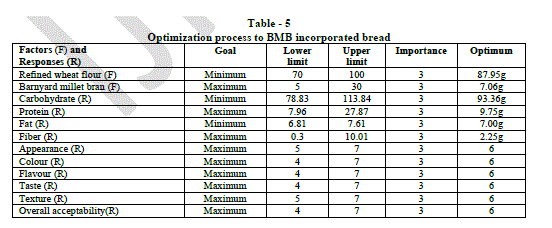 |
| Optimization was performed on the basis of a multiple response method called desirability. By applying the desirability function, the best optimum concentrations were attained for RWF 87.95g and BMB 7.06g. The calculated desirability for the formulation was 0.41. At these concentrations minimum carbohydrate 93.36g, fat 7g, maximum protein 9.75g, fiber 2.25g and overall acceptability of 6. Thus considering the above mentioned approach, the objective was to maximize the responses for protein, fiber and sensory score. |
CONCLUSION |
| Response surface methodology was successfully applied to optimize RWF and BMB to improve the quality of bread seems to be justified. The two variables employed in the study had a great effect on the quality of bread. Up to a certain limit of RWF addition, the carbohydrate and fat decreases while the protein, fiber, appearance, colour, flavour, taste, texture and overall acceptability increased. Modeling of experimental data allowed the generation of useful equations for general use, to predict the behavior of the system under different factor combinations. The final result of optimization suggested that the optimal ingredient doses to achieve with 87.95g RWF and 7.06g BMB for the bread |
References |
|